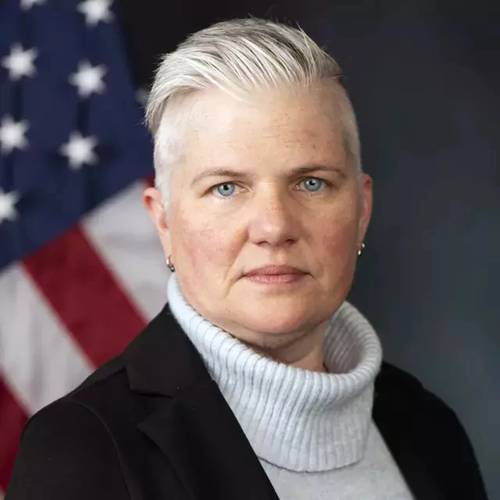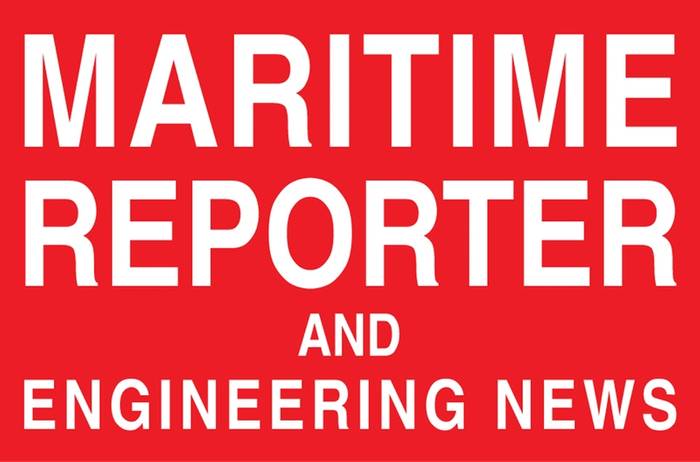Opinion
The Final Word
GAO: Coast Guard Should Better Monitor its Efforts to Credential Merchant Mariners
By Heather MacLeod, Director, GAO’s Homeland Security and Justice team
Engine Utilityman Dorian Reed, aboard USNS Walter S. Diehl (T-AO 193), explains the role of an engine utilityman. Diehl is one of 15 fleet replenishment oilers that make up MSC’s Combat Logistics Force.
Image courtesy DVIDS, Photo by LaShawn SykesMerchant mariners play a vital role supporting the U.S. maritime commerce industry which, according to industry estimates, generates nearly $5.4 trillion in economic activity annually. They can also be called upon to support national defense efforts by, for example, transporting military personnel and equipment. These civilian employees work on a variety of public and privately-owned U.S. registered vessels and may support the U.S. military in times of national emergency or war.
Vessel owners hire merchant mariners for various positions, each requiring different levels of skill and qualification. These mariners must possess a merchant mariner credential issued by the U.S. Coast Guard’s National Maritime Center, within the Department of Homeland Security. However, over the past several years, questions have been raised about the time it takes and the technology used to process credential applications.
In July 2023, the U.S. Government Accountability Office (GAO), the non-partisan, fact-based arm of the Congress, issued a report examining the Coast Guard’s merchant mariner credentialing process and its overall performance. The report found that the Coast Guard does not fully measure credential processing times and recommended they do so to remain responsive to mariners’ needs. While the Coast Guard agreed with the recommendation, their implementation timeline extends to 2029, and GAO did not believe that timeline would address mariners’ current needs.
Credentialing process
Over the past several years, the Coast Guard has taken steps to improve the overall timeliness of its credentialing process and responsiveness to mariners. The Coast Guard is modernizing its credentialing information technology infrastructure to eliminate most of the manual entry of applications, which are submitted by email, mail, fax, or in-person. The new system is designed to prevent the submission of incomplete applications—which can account for half of the applications received each year. Applications that require more documentation from mariners for the Coast Guard to assess—such as proof of eligibility for the type of credential the mariner is requesting—can take longer to process.
According to Coast Guard officials, they envision implementing a system similar to tax preparation software which would use easy-to-understand terminology, have checklists for required information, and have controls in place to ensure the inclusion of required supporting documentation. However, the Coast Guard does not anticipate full operational capability of this system until 2027 and would only take steps to start developing a processing time performance measure, as recommended by GAO, after the system has been in place.
Processing Volume and Timeliness
Completeness of merchant mariner applications is not the only thing that can affect processing times. The Coast Guard also said the volume of applications, their complexity, and Coast Guard’s human capital and technology resources also play a role in the timeliness of processing applications. According to Coast Guard officials, the existing volume of in-progress applications affects processing time of additional applications received. Typically, the Coast Guard experiences an increase in application volume in the spring season, compared to the other seasons. The Coast Guard officials said this volume increase is largely because of mariners seeking seasonal employment on passenger vessels (e.g., whale watching boats).
The complexity of an application also affects how quickly it can be processed, and applications go through multiple reviews for completeness, suitability, and to ensure the mariner meets the professional qualifications for the position. For example, there are about 100 endorsements (i.e., proof of qualification for a position) that a mariner could either be applying for or already have that an evaluator must verify. Applications for entry-level positions, such as ordinary seamen, wipers, and stewards, are generally less complex and may not require as much documentation. Conversely, applicants with a military background may submit more complex documentation and require an assessment by a more highly trained reviewer.
The GAO also reported that staffing challenges and antiquated equipment also affect processing time. For example, Coast Guard officials at the National Maritime Center, which processes merchant mariner credentials, said they typically operate with a 20 percent vacancy rate to process varying levels of applications. In 2022, this vacancy rate jumped to 33 percent among the higher qualified staff who process more complex applications. Additionally, the Coast Guard’s passport-style, double-sided printers often need maintenance that requires imported parts, which can add time to credential processing. In fact, when the GAO visited the National Maritime Center as part of their review, only one of the three printers used by the Center was operational, and staff were hand-laminating the credential booklets to help prevent the operational printer from becoming inoperable. At the time of the GAO’s review in the spring of 2023, the Coast Guard was considering alternative formats for issued credentials to reduce or eliminate reliance on these printers.
Measuring performance
The Coast Guard tracks its performance for processing credentials by using, among other measures, a goal they refer to as “net processing time.” The net processing time reflects the time the Coast Guard is actively processing an application and does not include time they wait for information from applicants. Because the Coast Guard’s processing time goal does not take into account the overall processing time—the time after the Coast Guard receives an application to the time it issues the credential to the mariner—the Coast Guard’s measure does not fully reflect what officials referred to as the “mariner reality.” This is because mariners are more likely tracking how long the overall process takes from the time they submit an application to the time they receive the credentials, if approved.
GAO found that, on average, the overall processing time was approximately three weeks longer than the net processing time that the Coast Guard uses to measure its performance. Additionally, from January 2018 through June 2022, the Coast Guard processed about 75 percent of applications in 60 days or fewer. The GAO recognized that the entirety of the merchant mariner credentialing process is not within the control of the Coast Guard, as they frequently need to wait for mariners to submit missing information. Nevertheless, the GAO believes the Coast Guard has sufficient data to be able to develop an overall processing time goal that is reasonable and would help fulfill its objective to improve service to mariners, the maritime community, and the public.
While the Coast Guard agreed with GAO’s recommendations to develop an overall processing time goal and use it to measure their credentialing performance, the Coast Guard does not anticipate fully addressing these recommendations until 2029. The Coast Guard explained its rationale saying the replacement for its credentialing database will transform the way the agency processes applications, and its efforts to address the recommendations are tied to that effort. GAO argued, however, that the recommendation implementation timeframes do not address mariners’ current needs and cautioned that the Coast Guard’s acquisitions plans could be delayed, extending implementation efforts even more. Additionally, the GAO said that without establishing a performance measure for assessing the overall processing time sooner, the Coast Guard will not be able to assess whether its modernization efforts are effective.

About the Author
Heather MacLeod is a Director in GAO’s Homeland Security and Justice team. She oversees Coast Guard and maritime security issues, including Coast Guard workforce and strategic planning efforts, and maritime port and supply chain/cargo security.

